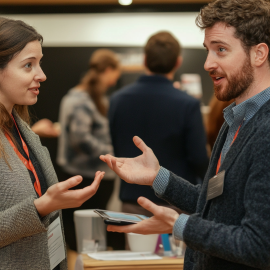

This article is an excerpt from the Shortform book guide to "Give and Take" by Adam Grant. Shortform has the world's best summaries and analyses of books you should be reading.
Like this article? Sign up for a free trial here .
What does it take to create a successful team? In what ways do givers make a team more successful? How can takers sabotage team’s performance?
Givers—as opposed to takers and matchers—increase the success of the whole team because they focus on the goals of the group rather than on themselves. Their giving tendencies also tend to rub off onto other members of the team, so the more givers there are, the better the team will perform as a whole.
Keep reading to learn why successful teams require givers.
Givers Collaborate Better
Americans tend to see independence as strength, and interdependence as weakness. Takers tend to see themselves as superior to others and collaboration as opening vulnerabilities to being overtaken.
In contrast, givers focus on achieving the goals of the group and see collaboration as harnessing the best of multiple people, ultimately creating a successful team. They take on tasks that are in the best interest of the group and not necessarily of themselves. This isn’t necessarily purely altruistic – givers understand that the best thing for themselves is for their group to perform as well as possible.
(Shorform note: In venture capitalist Ben Horowitz’s terms, “two percent of zero is zero.” If you’re a taker and fight for your share but the team fails, you own two percent more of nothing.)
Benefits of Giving in Collaboration
Evidence shows that the more giving team members are, the more successful they tend to be in group performance and individual raises. There are a few reasons for this.
When givers show they care more about the group, they signal that they care less about themselves and intra-competition. In turn, they earn their collaborators’ respect and trust, which opens bandwidth of collaboration. Takers no longer feel competitive with a giver, matchers feel they owe a giver, and givers identify with a giver.
As described before, giving and taking are both contagious. Because many people are matchers and use tit-for-tat strategies, adding takers to the mix promotes competitive and zero-sum behaviors that can drag the whole group down. People are wary of sharing creative ideas for fear of being exploited – indeed, taking behavior tends to lower creativity.
But adding givers to the group can push the whole group to focus on the overall goals and increase collaboration. Among a group of predominantly givers, people can feel more comfortable opening up and sharing ideas, building psychological safety. It feels safe to exchange information in an environment where you won’t be punished by bad actors.
Idiosyncrasy Credits
Giving also gives you a personal benefit – it increases the group’s reception to your personal ideas. Givers earn “idiosyncrasy credits” – positive impressions that allow a giver to deviate from group norms or expectations.
When givers voice their opinions, other members of the group are less entrenched in a competitive mood and can be more objective about ideas, because they know the giver is earnestly acting in support of the team. And when the idea is controversial or threatens the security of other team members, it’s understood that the giver is posing an idea primarily for the sake of the team, not for her own ego. This also applies to feedback – the recipient understands the giver wants her to succeed, rather than giving feedback to harm.
In contrast, when takers voice opinions, jealousy can spur collaborators to shoot them down in fear of competition or out of punishment for previous bad behavior. And when takers express threatening ideas or give constructive feedback, others can be skeptical of motives and reflexively dismiss it as self-serving.
Success Requires the Team
Much knowledge work relies on collaboration and working with a set of particular team members. It’s not as much a solo game where a superstar can join another team and magically make things work.
One study looked at the performance of cardiac surgeons who changed hospitals. The mortality rate for a given surgeon improved only at the specific hospital where they practiced – the surgeon’s general expertise didn’t carry over to other hospitals where she practiced.
In other words, every procedure the surgeon performed at one hospital lowered the mortality risk at that hospital. But when that surgeon switched to a different hospital, the mortality risk “reset.” This suggested that the mortality benefits of more operations came from the surgeon adapting to the particular team and environment, rather than developing a general skill that made her a better surgeon.
Similarly, investment banks often recruit star analysts from other firms. These top analysts earn 7 digits per year and are highly coveted. A given top analyst had a 10% chance of being ranked first when staying at the same firm. When moving to a different firm alone, performance dropped and their chance of ranking first was 5%. But star analysts who moved with their teams showed no decline in performance, keeping a 10% chance of being ranked first.
Both studies suggest that the supposed superstar – the surgeon and the star analyst – relies on their colleagues for top performance.
Geniuses vs Genius Makers
A 1958 study collected the top 40 creative architects (by surveyed opinion) and 84 successful but uncreative architects, and studied the groups psychologically. They found that the ordinary architects were more likely to be givers, showing good character and sympathetic concern. The creative architects were more “demanding, aggressive, and self-centered.” Later studies among scientists showed similar results, with takers agreeing to statements like “I tend to slight the contributions of others and take undue credit for myself.”
Because takers tend to be self-confident and care less about what others think, they can push original ideas against opposition. But that also comes with costs.
Adam Grant spends much of this chapter on portraying two people on opposite sides of the spectrum: Frank Lloyd Wright as a taker, and former Simpsons writer George Meyer as a giver.
Wright is recognized as one of the greatest architects of all time, but he was notoriously difficult to work with. He refused to pay his apprentices and demanded that his name be featured as lead architect on their designs, even when he didn’t do most of the work. When his son John asked to be paid for his work as an assistant, Wright gave a bill itemizing his costs since birth. For his famous Fallingwater house, Wright ignored his client’s request to see the waterfall from the house, designed a house that sat on top of the waterfall, and charged triple the contract. (A giver likely would not have gone against his client’s wishes so egregiously.)
Wright’s taker stance bolstered his prestige and gave him the courage to push original controversial ideas, but it came at a cost. Few of his hundreds of apprentices became successful architects – the best apprentices quit after feeling exploited. He left a legacy of his own work, but he didn’t boost the careers of followers.
George Meyer, in contrast, is a giver. As a writer on Saturday Night Live, he would take on the grunt work of writing sketches for less glamorous guests – “I just wanted to be a good soldier.” As a writer on The Simpsons, he worked more on rewriting other people’s first drafts, rather than pushing his own first drafts (which would have his name credited front and center). He’s shaped more than 300 episodes but credited as a writer on only 12, despite the consensus among writers that he was responsible for many of the jokes. Adam Grant argues that despite his relative anonymity for many years, he eventually got deserved credit through a feature in The New Yorker and multiple Emmys.
And in contrast to Wright, Meyer has helped the careers of many writers who are universally grateful. These include actor Bob Odenkirk and Fresh Prince creator Andy Borowitz.
Adam Grant gives Jonas Salk as another example of a taker. He was publicly credited as a miracle worker in polio vaccine development, but at an important press conference, Jonas Salk refused to acknowledge the work of colleagues and his lab researchers. This snub alienated his colleagues and the overall scientific industry, which viewed it as “the most un-collegial thing that you can imagine.” He in turn never won a Nobel prize and was never elected to the National Academy of Sciences (retribution for taker behavior). Salk, in his taker worldview, simply interpreted the world’s reaction as jealousy for his accomplishments.
Why Takers Act Poorly
Takers don’t always maliciously and consciously take the effort away from people. People generally want to think of themselves as fair and good. Rather, it can be due to a lack of affective empathy, which distorts their view of the world.
Imagine you and your partner are asked about how much you each contribute to the relationship, from 0 to 100 percent. Three out of four couples add up their personal contributions to more than 100%.
This is the responsibility bias: we exaggerate our contributions relative to those of others. This happens partly because of ego (we want to glorify ourselves) but also because of information discrepancy: our own actions are far more salient to us than other people’s actions. For example, when itemizing each partner’s contributions, people tend to list 11 of their own but only 8 of their partner’s.
Wright and Salk, for instance, remembered how hard they toiled to generate the successes, but they hadn’t viscerally experienced the pain of their subordinates.
There is an antidote to responsibility bias: list what your partner has contributed before you estimate your own contribution. When employees first think about how much their bosses have helped them before valuing their own contributions, they double the % of their bosses’ contributions, from 17% to 33%. Similarly, in group work, considering others’ contributions first brings the sum of individual contribution estimates down from 140% to 123%.
Givers tend to default to recognizing the value of what other people contribute first, and to see themselves as assisting the capabilities of others. This gratitude promotes a giving behavior, since you underplay your own contributions and jockey less for credit.
The Perspective Gap
The chasm of empathy causing responsibility bias is called the perspective gap. When we’re not currently experiencing an intense state, we underestimate how much it’s affecting us or others.
- Doctors consistently think their patients are feeling less pain than the patients themselves rate.
- When you have your arm in a bucket of ice water, you predict that being in cold will be 14% more painful than if you had your in a bucket of warm water. And there is a fast decay in perspective – someone who is exposed to cold water and then 10 minutes of warmth rate cold pain as though they had never experienced the cold water.
Takers rarely cross the perspective gap. Narcissistically, they focus on their own viewpoints and rarely see how others are reacting to their ideas. Takers project their own feelings on other people, and behave in accordance to how the takers would like to be treated.
For example, gift-givers routinely overestimate how much recipients enjoy off-registry gifts. Stuck in their own frames of reference, gift-givers give what they would prefer themselves, rather than accurately appreciating what the recipient would enjoy. If you love Dutch ovens, you think others would love them too; but if they loved them that much, the recipient would have put Dutch ovens on the registry.
(Shortform note: problematically, takers may see themselves as far more empathetic than they really are (because their ego would not let them believe they’re manipulative). When empathizing with another person, a taker believes she is imagining how the other party is feeling. But in reality, the taker is imagining how the taker would feel in that situation. This is a false, self-centered empathy.
Thus narcissists tend to see themselves as righteous and doing nothing wrong, and when others react poorly, narcissists may dismiss the insulted parties as unlikeable rather than assigning blame to themselves.
This also suggests that empathy really requires an accurate understanding of the other person’s state. You must fully inhabit the other person’s mind and assume nothing that is not proven.)
How Empathy Develops with Age
Other-centered empathy develops between 14 months and 18 months of age. Toddlers are given two bowls, one with crackers and another with broccoli. They overwhelmingly personally prefer crackers. They then watch a researcher express disgust while eating crackers and happiness while eating broccoli. The researcher then asks for food. 87% of 14-month-olds erroneously shared the crackers, while 31% of 18-month-olds did.
Over time, some people may naturally incline toward this empathy more than others. Givers tend to actively empathize with the other party. Before giving feedback, comedic writer George Meyer reflects on his past feelings of feeling eviscerated when being rewritten.

———End of Preview———
Like what you just read? Read the rest of the world's best book summary and analysis of Adam Grant's "Give and Take" at Shortform .
Here's what you'll find in our full Give and Take summary :
- The three reciprocity styles—givers, takers, and matchers
- Why givers are the most successful in life
- How to set up a giving culture






